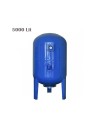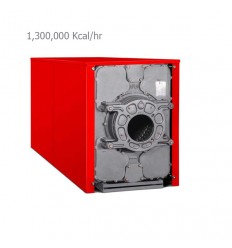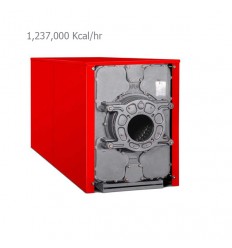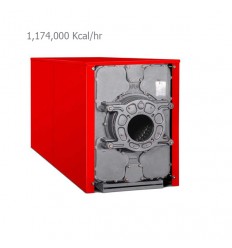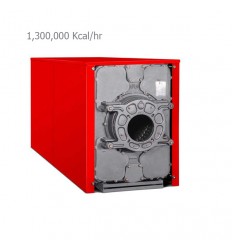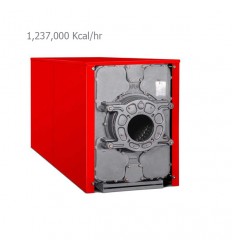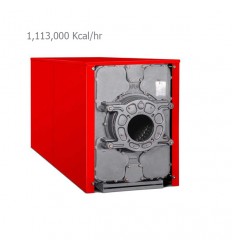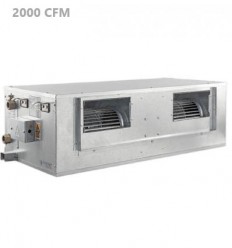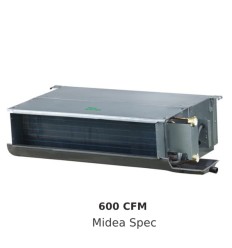- On sale!
- Out-of-Stock
-
Account
-
-
Shopping Cart
Cart is empty.









Type
Type
Capacity
Capacity
Brand
Brand
Price
Price
-
IRR0 - IRR641,610,000
On sale
Chauffagekar Star 1300-20 Cast Iron Boiler
- Dimensions of the boiler (length, width, height): 3680 * 900 * 1200 mm
- Number of blades: 20
- Working pressure: 10 bar
- Avoids energy loss with complete insulation of the cloak
Warranty :
10 years Chauffagekar warrantyWarranty and after-sale Services:
10 years
Warranty terms: 10 years warranty since installation- On sale!
Chauffagekar Star 1300-19 Cast Iron Boiler
- Heating energy: 1237000 kcal/h
- Boiler dimensions (length, width, height): 3520*900*1200 mm
- Number of blades: 19
- Working pressure: 10 bar
- Fuel type: natural gas or gasoline
- On sale!
- On sale!
- Out-of-Stock
Chauffagekar Star 1300-18 Cast Iron Boiler
- Heating energy: 1174000 kcal/h
- Boiler dimensions (length, width, height): 3360*900*1200 mm
- Number of blades: 18
- Working pressure: 10 bar
- Fuel type: natural gas or gasoline
10 Years Warranty
10 years
- On sale!
Chauffagekar Superheat 1300-20 Cast-Iron Boiler
- Heating energy: 1,300,000 kcal/h
- Boiler dimensions (length, width, height): 3680*900*1200 mm
- Number of blades: 20
- Working pressure: 6 bar
- Fuel type: natural gas or gasoline
10 Years Warranty
10 years
- On sale!
Chauffagekar Superheat 1300-19 Cast-Iron Boiler
- Heating energy: 1237000 kcal/h
- Boiler dimensions (length, width, height): 3520*900*1200 mm
- Number of blades: 19
- Working pressure: 6 bar
- Fuel type: natural gas or gasoline
10 Years Warranty
10 years
- On sale!
Chauffagekar Star 1300-17 Cast Iron Boiler
- Heating energy: 1113000 kcal/h
- Dimensions of the boiler (length, width, height): 3200*900*1200 mm
- Number of blades: 17
- Working pressure: 10 bar
- Fuel type: natural gas or gasoline
- On sale!
Ceiling, Floor and Ducted Fan coil Unit
Fan coil units are used to provide cooling and heating in buildings. They are produced in ground, ceiling, ducted, ceiling and wall types. In the following, the technical specifications, working pressure, capacity calculation, how to check and the best price of all types of fan coil units are presented for wholesale purchase.
A Guide to Selecting Ceiling, Floor, and Ducted Fan Coil Units
What is a fan coil unit? A fan coil unit is the smallest component of an air conditioning system used to transfer chilled water temperature from the chiller or hot water from the engine room to the ambient air. Fan coils usually have a two-pipe temperature exchanger coil for the inlet and outlet of chilled water from the chiller (in summer) and hot water from the engine room or package (in winter) and cannot cool and heat simultaneously. (Except when four-way solenoid valves are installed and a four-pipe fan coil is used). There are different fan coils in terms of use, installation location, and appearance, which we will describe in detail below.
Components of Ceiling, Floor, and Ducted Fan Coil Units
The internal parts and main components of the fan coil include the cabinet, coil, motor, fan, electrical box, and distillation tray, the use and operation of each of which are explained below:
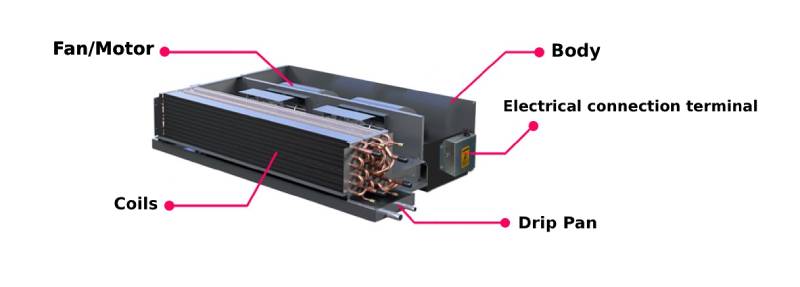
- Fan: The fan installed in the fan coil moves and directs air over the coil's surface and into the desired environment. Different companies and manufacturers make different designs of the fans used in all types of fan coil units according to parameters such as sound level and providing the required air pressure to pass over the fan coil or duct. The material of the fans can be plastic, polyamide, or metal, which naturally vary in price to some extent.
- Coil: The coil or coils in the design of the fan coil system are a type of heat exchanger that is the place where cold or hot fluid passes. These coils are made up of several rows of copper tubes with aluminum fins and are known as (names of coils: two, three, and four rows) according to the amount and number of rows of copper tubes used. As three and four-row coils have more copper tubes and, therefore, more hot water capacity, their heating and cooling capacity is higher.
- Fan Motor: The motor or fan motor rotates and controls the unit's fan speed. Electric motors are available in 2 types (three turns or four turns) and are controlled by a button or digitally.
- Filter: The filter is placed in the air inlet of the fan coil to prevent dust and foreign objects, such as insects, from entering the unit.
- Drip Tray: The drip tray in the fan coils collects water droplets from distillation in the coils. It has a pipe to drain the water.
- Electric box: The fan coil's electric motor uses an electrical box for power and operation.
The Operation of the Fan Coil Unit
One of the most important questions before buying a fan coil is how it works.
The fan coil works because when switched on, the airflow in the room is drawn into the unit by the blowing fans. This air then passes through the unit's filter and coil (or heat exchanger) in cooling or heating mode, blowing a stream of cold or warm air back into the room. This cycle is repeated continuously in the fan coil unit until the air in the room reaches the temperature desired by the user. An analog or digital selector switch or thermostat on the wall controls and regulates the room temperature.
Note that to cool the fan coils, cold water flows through the chiller in the copper pipes connected to the two units and is transferred to the coils; similarly, to heat the coils, hot water flows through the copper pipes through the central machine room or package and enters the coils. The following diagram shows the operation of the fan coil system and its internal components:

Ceiling, Floor and Ducted Fan coil Unit Applications
Fan coil units are responsible for providing cool air in summer and warm air in winter, and this is done by passing air through a copper coil containing cold water from the chiller (in hot seasons) and hot water from the engine room or package (in cold seasons).
In general, fan coils are used in cases where we want the temperature of each area to be controlled separately by a thermostat installed in the same area.
One of the other advantages of fan coils is preventing the flow and transfer of air and possible air pollution between different rooms of a residential, office, accommodation, health, and hospital unit.
Different Types of Fan Coil Units
Five main fan coil units are available, including floor fan coil units, ceiling fan coil units, cassette fan coil units, wall-mounted fan coil units, and ducted fan coil units. We will explain each one shortly:
Floor-mounted fan Coil Units
Built-in floor-mounted fan coil units are usually manufactured and supplied with 200 to 1200 cubic feet per minute (CFM) ventilation that emits cool or hot air as updrafts. As their name suggests, these fan coil units are installed on the floor.

Ceiling Fan Coil Units
There are four types of ceiling fan coils, which are as follows:
1. Recessed Ceiling Fan Coil Units: Recessed ceiling fan coils (bottom suction - rear suction), available in cab and cab models, have ventilation capacities of 200 to 1,200 cubic feet per minute (CFM). These devices are usually installed inside the false ceiling (at the entrance of each room), and only their valve can be seen from inside the room. One of the important advantages of these fan coils is low noise production and not occupying the environment space.

2. Surface-Mounted Ceiling Fan Coil Units: these devices are produced in two types, low-pressure and high-pressure, and in terms of performance, they are similar to built-in ceiling fan coils (suction from below - suction from the back), With the difference that the body of these fan coils are fully exposed and occupy more space.
3. Cassette Fan Coil Units: Cassette fan coil units are a type of ceiling fan coil installed inside the false ceiling; however, controlling and adjusting their temperature or speed can be done by remote control in addition to the wall thermostat panel.
Regarding ventilation, ceiling fan coil units have one-way and four-way types. In terms of connected pipes, they have two-pipe and four-pipe types, which provide the possibility of providing cooling and heating simultaneously.
4. Ducted Fan Coil Units: Ducted fan coil units are usually produced in capacities of 600 to 2000 cubic feet per minute (CFM) and in two types: horizontal and vertical. It is necessary to check whether it is horizontal or vertical and the dimensions of the required ducted fan coil before inquiring about the price or placing an order.

Wall-Mounted Fan Coil Units
Wall-mounted fan coil units, which have been available for some time, have attracted the attention of builders of construction projects and are installed on the wall.
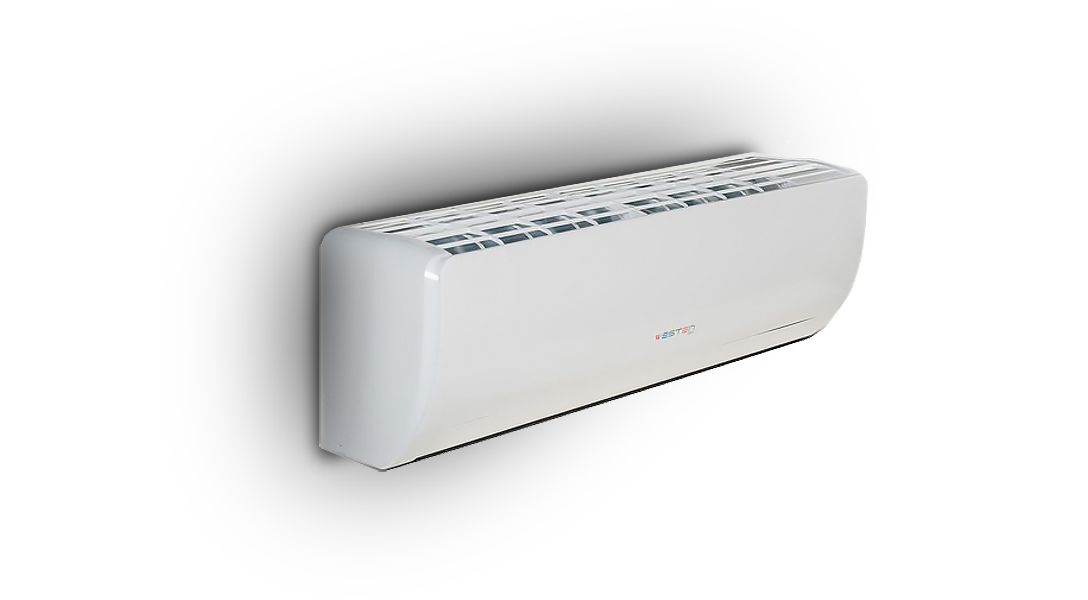
Note: Before placing the order for the desired fan coil unit, determine whether the fan coil pipes are connected to the left or right side of the device, which is a crucial factor for these devices.
Important Factors to keep in mind when buying a Ceiling, Floor and Ducted Fan coil Unit
Numerous factors must be considered when selecting a fan coil unit to ensure optimal performance and efficiency. One of the primary factors to consider is the type of fan coil unit needed for the specific application. The unit's cooling and air delivery capacity should also be evaluated to meet the required specifications. The unit, coil, fan, and body size must also be evaluated to ensure quality and efficiency.
Appearance may also be a consideration, particularly in high-end hospitality and office spaces, where the unit's aesthetics can impact the overall ambiance. Finally, mobility may be a factor for some applications, as changes in water supply temperature can impact cooling capacity, requiring the unit to be moved to a different location. Read on if you need more info about these factors; otherwise, you can skip this part:
1. Type of the Fan Coil Unit
As we mentioned, fan coil units have different types, such as ground fan coil, facing, inclined, built-in ceiling fan coil, four-sided and two-sided ceiling fan coil, wall fan coil (such as split panel), ducted fan coil, etc., are selected based on your needs. You can also use our experts' advice to ensure that the device you get suits your place perfectly.
| Fan coil unit Type | Air capacity(CFM) | cooling capacity (kW) | heating capacity(kW) |
|---|---|---|---|
| wall-mounted | 600 - 200 | 5.5 - 1.5 | 10 - 2.8 |
| floor-mounted | 1200 - 150 | 11.9 - 1.7 | 19.7 - 3.9 |
| ceiling fan coil | 1200 - 200 | 12.5 - 1.7 | 19.5 - 3.5 |
| cassette fan coil units | 1200 - 300 | 13.5 - 2.6 | 22 - 4.5 |
| high pressure cassette fan coil units | 2200 - 600 | 23.1 - 6.1 | 41 - 11.5 |
2. The capacity of the Fan Coil Unit
The most important factor in choosing a fan coil unit is the suitability of its cooling and heating capacity. When calculating, the capacity of the fan coil is determined based on the total cooling load (sensible and latent evaporation) of each space by the project facility engineers or after consulting with the experts of the air conditioning equipment department.
The following table shows how to choose the appropriate approximate capacity of the fan coil for installation in residential and office buildings in temperate climates such as Tehran, Mashhad, Karaj, Isfahan, Erbil, Kabul, Sulaymaniyah, Aleppo, Rasht, Sari, Shiraz, Kermanshah. , it shows Kirkuk, Mosul, Antalya, Mazar-e-Sharif, Latakia, Hama, etc. The capacity of the fan coil is usually displayed in terms of CFM, which indicates the volume of cubic feet of ventilation of the fan coil per minute.
The estimation of the required fan coil unit capacity for each of the sizes presented in the table below is approximate based on the temperature conditions of the design and the maximum fan speed. In the average speed, the correction coefficient of the ventilation volume of the fan coil units compared to fast speed is about 0.8, and the correction factor for cooling and heating power at medium speed is about 0.85.
Remember that you can always contact the experts of DamaTajhiz HVAC Group.
The approximate estimate of the fan coil required for Tehran's weather conditions is presented in the table below.
| Fan coil capacity | Maximum infrastructure used |
| 200CFM | to 12 mm |
| 300CFM | to 20 mm |
| 400CFM | to 28 mm |
| 600CFM | to 40 mm |
| 800CFM | to 56 mm |
| 1000CFM | to 70 mm |
| 1200CFM | to 80 mm |
| 1400CFM | to 95 mm |
| 1600CFM | to 110 mm |
| 1800CFM | to 120 mm |
| 2000CFM | to 140 mm |
Basically, to calculate the required fan coil unit's capacity of each of the building spaces in "hot and dry" weather conditions such as the cities of Zahedan, Kerman, Yazd, Zabul, Medina, Karbala, Najaf, etc. or "hot and wet climate" such: Ahvaz, Bandar Abbas, Abadan, Bushehr, Chabahar, Kish, Basra, Dubai, Sharjah, Doha, Kuwait, Muscat, Karachi, Jeddah, Baghdad, Riyadh, Damascus, Sana'a, Makkah, etc.
Calculating the required cooling load for each room is the main priority.
But in cold weather conditions, such as the cities of Zanjan, Ardabil, Tabriz, Urmia, Bojnord, Hamedan, Qazvin, Baku, Yerevan, Astana, Dushanbe, Ankara, Tashkent, Khojend, Samarkand and even the great city of Istanbul, the priority of calculating of the capacity is mainly based on the required heating load of each room.
3. Size/Dimension of the Fan Coil Unit
You do not want to face the problem of your fan coil unit not fitting in the desired location after you purchase the device, so make sure you choose wisely and always do your calculations before anything else. We emphasize again that the fan coil unit dimensions, particularly in the cassette fan coil units, are very important.
4. Heating/Cooling Coils of the Ceiling, Floor, and Ducted Fan coil Unit
The coil is the passage of cold or hot fluid, consisting of several rows of copper tubes with aluminum fins.
These are what you should look for when it comes to choosing a coil: the arrangement of the pipes, the number of rows, the type of protective coating on the fins (bluefin, gold fin), the type of pipes, the number of fins per unit and their waveform.
Three rows of 3/8 inch copper pipe are usually used in almost every coil type. Still, if a double-row coil with a diameter of ½ inch is used, it can reduce the heating efficiency and the pressure drop of the carrier fluid flow.
It is better to use a double-coil fan coil unit if you want to have the ability to switch between hot and cold modes through day and night. The same thing goes for large buildings. So that one of the coils can be used for cold water flow and providing cooling and another coil as well) It is used to supply the flow of hot water to the boiler and provide heating. These types of fan coil units are called four-pipe fan coil units.
In other words, regular single-coil, two-pipe fan coil units connect a pipe to the input water and another to the output water.
But four-pipe fan coil units have two coils, two pipes for hot water input and output and two for cold water input and output.
By using double-coil or four-pipe fan coil units, you can switch between cold or hot temperatures with a single button in addition to cooling one part of a building and heating another part. Four-pipe fan coil units must be equipped with an electric valve, and according to the thermostat command, cold or hot water flows in one of the two coils.
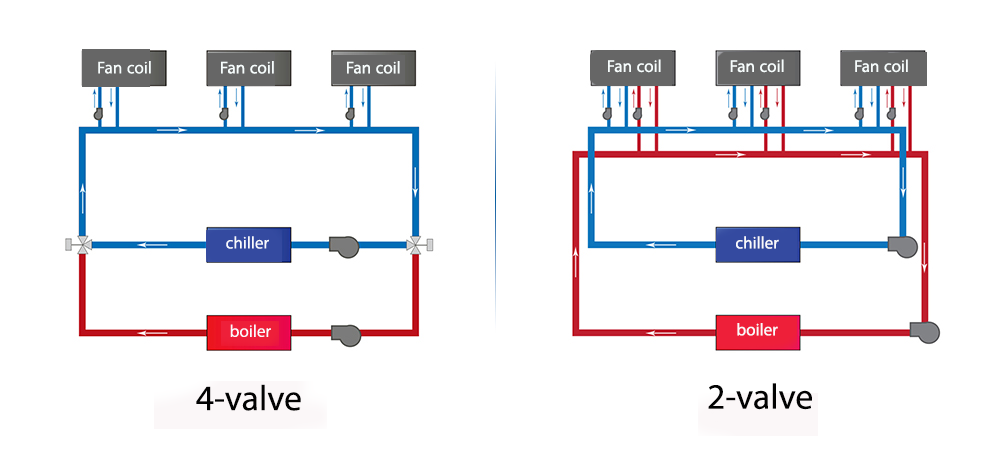
Note: There are several control valves on the way of the fan coil piping to change the direction or flow of water. Also, in two-pipe fan coils, due to the unavailability of hot and cold water at the same time, a sensor or changeover valve is placed in its piping path.
5. Working Pressure of the Fan Coil Unit
Considering that in buildings taller than 20 floors, the water pressure inside the coil will be more than 8 bar or about (PSI 120), when choosing a fan coil, consider the water pressure inside of the coil for high-rise towers.
6. The Motor
Electric motors of the fan coil units can vary from ones with 3-speed levels up to those with 8-speed levels, and they are usually made in two types: sealed or repairable. Mechanical parts and equipment of the fan coil units, such as bushes, shafts, ball bearings, etc., are made in different qualities, which can greatly impact the fan coil unit's sound level and lifespan.
The motor of the fan coil must be multi-speed and low noise with very reliable ball bearings so that the operating noise of the electric motor and the ventilation fan is less than 35 dB.
7. Working Fans
What the fan does is simple: it first directs the airflow over the coil's surface and then redirects it to the environment. The manufacturing companies of these fans have to consider major parameters, such as the sound level and the required air pressure to pass over the fan coil or channel when making these parts.
They make these parts out of either metal or compressed ABS plastic, each with advantages and disadvantages. Therefore, according to the device's application and the type of centrifugal ventilation, select the most effective type that suits your needs the best.
Another important topic to put to the examination is that these fans are usually produced in low-pressure at 30-pascal and high-pressure at 120-pascal types (for ducted fan coil units), and the power of the fan is generated by an electric motor, which we have talked about in the previous title.
The centrifugal fan should be made out of metal to maintain a dynamic balance during long operations, which, in this case, provides the required aeration volume of the fan coil more completely. However, if it is made of ABS, it will be less pricey.
Notes:
Using the ABS fans is not recommended for areas with cold winters, and the water temperature of their central heating system is around 80 degrees Celsius in winter. In the long term, this temperature can change the shape of the fan in the vicinity of the hot water, which will end up with a louder sound for your device.
In fact, the best option for airing fan coils is to use high-quality polyamide fans with carbon fibers, which, in addition to providing enough air with the lowest possible noise, are resistant to temperatures up to 120 degrees Celsius and do not change shape; Of course, on the other hand, the provision of polyamide fan is more expensive than both options of galvanized fan and plastic fan, and its provision may have higher time and cost for the manufacturer.
8. The Appearance and Body of the fan Coil Unit
The body of the fan coil should be integrated so that it does not cause vibration and noise between different parts of the body over time. The beauty of the fan coil, especially the ground fan coil, which is practically one of the visible components of your building, should also be fully considered in the selection of the fan coil.
9. Usability and Mobility of the Fan Coil Units
The start time, change of speed, or shutting off the ventilation fan motor can be done manually and automatically. The best method for ceiling, wall, and ceiling fan coil units is a two-season, three-cycle automatic thermostat and an electric three-way valve.
All the floor fan coil units have a manual turn-on and off switch and a setting switch, but installing an automatic thermostat is one way to get the best out of their performance and optimize energy consumption. Turning on and off operation and changing the speed level of the blower motor is done by a room thermostat installed at a height of 140 cm from the ground and away from the airflow of the fan coil outlet and direct sunlight.
In a complementary way, by installing a gradual two-way solenoid valve or installing a three-way motorized valve, as well as by implementing the bypass route, it is possible to adjust the flow rate of cold or hot water by using the command received from the thermostat installed in each of the spaces. The inlet to the water supply pipe of the fan coil units also accurately controlled the supply of hot air and cold air by the fan coil units.

10. Fan Coil Unit's Price
The price can be decisive when buying any product, yes, but when it comes to buying a product like a fan coil unit, which is a device that you can use for a long time, you do not want to miss some very important features just to spend a few less bucks. Features such as the lifespan of the device, sound level, efficiency, capacity, appearance, warranty, and after-sales service are also very important. Therefore, it is safe to say that the fan coil price is not the most important factor considering its application.
Note : When buying a fan coil unit, it is important to pay close attention to this checklist: the type of fan coil you want to buy (regardless of the quality of the brand), the usage, architectural design of the building, parts, installation location, exact capacity, Dimension of the device, working pressure, construction quality of the device and its materials.
Fan Coil Testing and Verification
Considering the importance of fan coils as the final equipment for providing cooling and heating in projects, in cases where the number of fan coils required is high, usually, the consulting engineer or technical representative of the employer receives different samples of fan coils from different companies and selects them. In terms of the following items, they are examined and tested.
- The appearance and dimensions of the device: due to the limitation of the installation space in the false ceiling of most projects, the dimensions of the fan coil and the possibility of its placement, especially in the false ceiling of each building space, are very important.
- The amount of output aeration volume: To measure the amount of actual aeration volume of a fan coil device and compare it with the number provided in the catalog of the supplier company, they use a laboratory kit called a CFM meter, which is usually accompanied by the representative of the selling company for performance testing. A fan coil bag is included.
- Measuring the amount of sound produced by the device: one of the important parameters in choosing a fan coil is the amount of sound produced by the device, which is used to measure the sound level of the device using a decibel meter.
- Sound and thermal insulation: the use of sound and thermal insulation with high quality, long life, and suitable thickness is also one of the parameters that play a significant role in the final selection of the fan coil. Failure to use proper insulation increases the sound of the device and wastes energy in it.
- The Quality of Materials: use of high-quality galvanized sheet with suitable thickness, use of high-quality electric motor, material of fan and fan blower, quality of construction and galvanized material of drain tray, etc., are also very important things that buyers should consider. Pay attention to them when choosing a device.
Buying Floor, Ceiling, Ducted, and Cassette Fan Coil units
Out of all the mentioned aspects, the first step to choosing a fan coil unit should be to pay attention to the capacity, type of device, and dimensions of the installation location. Because fan coil units are produced and supplied in different types with different ventilation capacities, you should consider the size of your environment before buying a fan coil unit. This is how you choose the right device with the right price. After those three aspects, things like the type of ventilation fan, coil specifications, working pressure, and fan coil brand should be considered.
On DamaTajhiz HVAC Group, technical information of dozens of models of fan coil units from reliable brands with original warranties has been presented for you to enjoy the good feeling of optimal and smart shopping.
Also note that in the specialized HVAC group of Damatajhiz, all the fan coil units are only sold in bulk. Therefore, if you want to wholesale any of these products, contact us.
DamaTajhiz HVAC Group; The best prices and brands of construction equipment

Fan Coil Unit's Price
The price can be decisive when buying any product, yes, but when it comes to buying a product like a fan coil unit, which is a device that you can use for a long time, you do not want to miss some very important features just to spend a few less bucks. Features such as the lifespan of the device, sound level, efficiency, capacity, appearance, warranty, and after-sales service are also very important. Therefore, it is safe to say that the fan coil price is not the most important factor considering its application.
Note : When wholesale buying a fan coil unit, it is important to pay close attention to this checklist: the type of fan coil you want to buy (regardless of the quality of the brand), the usage, architectural design of the building, parts, installation location, exact capacity, Dimension of the device, working pressure, construction quality of the device and its materials.
The Advantages of Fan Coil Units
The following are some of the most important advantages of the fan coil unit:
The possibility of using fresh air in channel fan coils
- The failure of a fan coil does not affect other devices
- The possibility of controlling and adjusting the independent temperature of different spaces of the building
- Small installation space and no need for false ceiling and ducting in-ground and wall fan coils
- Variety in the design of fan coil units and the possibility of using different types of fan coil according to the needs of the project and building architecture
- Possibility of unlimited use of several fan coils with one or two chillers or a central engine room in large spaces
- Saving energy consumption by using heating through hot water coils and switching on and off intermittently (manually or automatically) the fan coil in empty spaces.
Technical and Installation Factors of the Ceiling, Floor, and Ducted Fan Coil Units
There are a few factors that must be taken into account when buying a fan coil unit, which are as follows:
- To calculate the cold water flow required for the fan coil units, the cooling capacity based on BTU/h of each building's spaces should be divided by 5000. (or dividing kilocalories per hour by 1250), this is how the diameter of the hot and cold water return pipes to the 200 cfm fan coil units is ½ inch. For 300 and 400 CFM fan coil units, ¾ inch and the fan, 600, 800, and 1000 cfm coils are 1 inch in size, and for 1200 fan coil units and channels up to 1800, ¼ 1 inch is considered.
- It is necessary to install a flow switch in the path of the outlet water of the evaporator towards the cold water coil of the air conditioning equipment to stop the chiller when the circulator pumps of the cooling circuit are turned off.
- Due to the greater heating ability of fan coil units than radiators of the same size, in old buildings, it is possible to install a fan coil instead of a radiator (only for heating) if the relevant pipes are from the floor of the unit (not from the back wall device) have been removed.
- Due to the importance of ventilation fan balance in the performance of fan coil units and its direct relationship with the lifespan of motor bearings as well as the noise level of the device, to maintain the dynamic balance of the ventilation fan of the device, compared to the completely horizontal and aligned installation of all types of fan coil units Pay utmost attention to your installation location.
- Due to the important issue of service and maintenance in air conditioning equipment, including fan coil units, installing the shut-off valve for the inlet and outlet water flow from the fan coil units and the relevant tube nut is necessary.
- To collect the water from the distillation of air humidity on the coils in summer, installing an ½ inch drain pipe from the tray under the coil to where these waters are drained is necessary.
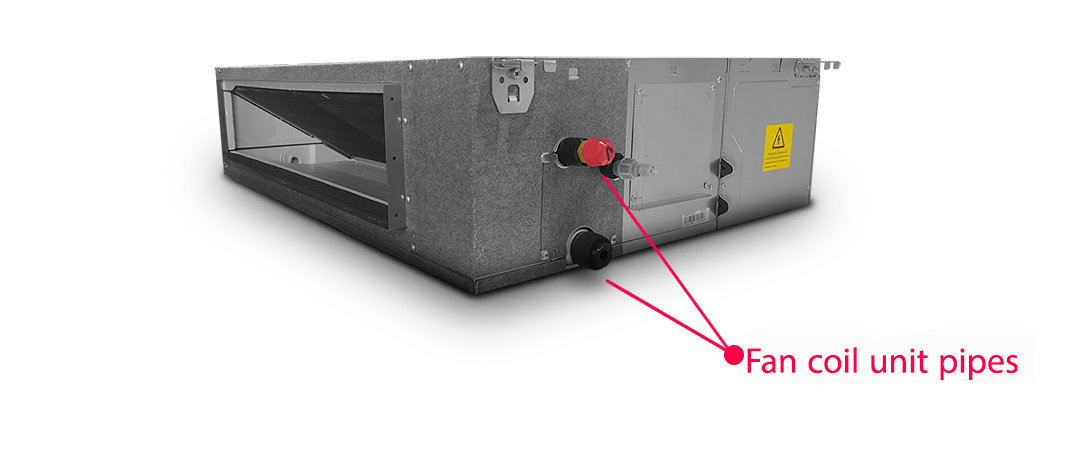
Dear users:
Reading the stated information above to obtain additional information to purchase the types of ceiling, floor, wall-mounted, and ducted fan coil units. You can also contact the experts of the AC equipment by dialing one of the extension numbers 117-119-120-126-317 to get advice or just to ask your questions.
Dear users, while thanking you for the trust you put in the technical opinions of heating equipment sales experts of DamaTajhiz, it should be noted that the choice of the desired product brand based on history, brand strength, service, and product price is ultimately determined by the buyer. But in the field of fan coil units, most of the users and buyers choose and buy best-selling brands such as ventilation, Saran, DamaTajhiz, Saravel, and G Plus due to their quality, price, and after-sales service.
Also, considering that the DamaTajhiz HVAC Group is a member of the main group specializing in heating equipment, is the first and most viewed authority for selling air conditioning equipment, and is an official member of the heating and air conditioning equipment sellers' union. Therefore, it is safe to say that we provide all kinds of fan coil units in the Middle East region. Therefore, if you are from the same country in the region and you need a fan coil unit, please place your order with our sales experts team. Product warranty and a reasonable price are included.
" Buy with confidence and peace of mind from DamaTajhiz HVAC Group"

Trademark registration certificate - Stewardship business license from Virtual Business Association - Business license from Heating and Air Conditioning Equipment Association

The presence of DamaTajhiz HVAC Group in international exhibitions of construction facilities and cooling and heating systems

We await your call and look forward to meeting you in the DamaTajhiz HVAC Group.
Sharing the above texts on social networks lets your friends know its important content.
| |
There are 576 products.
Active filters
- -5%
- On sale!
- -5%
comments
(0 comment)add comment
Shopping Cart
Cart is empty.




